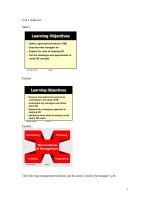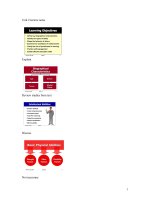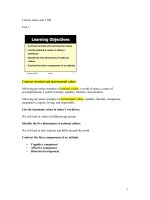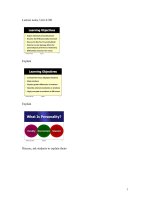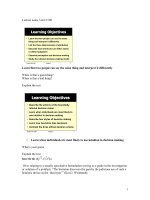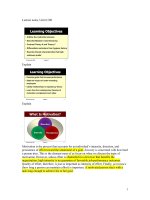Organizational behavior: Lecture 42 - Dr. Mukhtar Ahmed
Bạn đang xem bản rút gọn của tài liệu. Xem và tải ngay bản đầy đủ của tài liệu tại đây (511.93 KB, 37 trang )
Organizational
Behavior
(MGT-502)
Lecture-42
Summary
of
Lecture-41
Basic OB Model
Organization
systems level
Group
level
Individual
level
Understand
organizational
events
Influence
organizational
events
Organizational
Behavior
Research
Predict
organizational
events
Today’s Topics
High-Performance
Organization?
Basic Systems View of
Organization
Environment
INPUTS
Human,
physical,
financial, and
information
resources
TRANSFORMATION
PROCESS
Feedback
loops
OUTPUTS
Products
and
Services
High-Performance Organization?
• Organization’s mission
• Strategies
• Goals
Quality
A Concept critical to the
performance & survival of virtually
every organization---quality.
“In the search for quality there’s
no such thing as good enough;
there’s is never a finish line”
K. Theodor Krantz
What is a High-Performance
Organization?
Total quality management (TQM).
• A total commitment to:
– High-quality results.
– Continuous improvement.
– Customer satisfaction.
– Meeting customers’ needs.
– Doing all tasks right the first time.
• Continuous improvement
focuses on two questions:
–Is it necessary?
–If so, can it be done better?
High-performance organizations
• Value and empower people, and respect diversity.
• Mobilize the talents of self-directed work teams.
• Use cutting-edge technologies to achieve success.
• Thrive on learning and enable members to grow and
develop.
• Are achievement-, quality-, and customer-oriented, as
well as being sensitive to the external environment.
Quality
Essential Elements of TQM
• A supportive organizational culture
• Management commitment and leadership
• Provide a sense of direction
• Analysis of customer quality needs
• Benchmarking
• Standards
Essential Elements of TQM (cont..)
• Strategies to close quality gaps
• Training
• Quality teams
• Progress monitoring and measurement
• Exceeding customer expectations
Can we do it?
What Is Performance
Management?
• It is a systematic process of
–Planning work and setting expectations
–Continually monitoring performance
–Developing the capacity to perform
–Periodically rating performance in a
summary fashion
–Rewarding good performance
Performance Management
1. Planning
2. Monitoring
Set goals and measures
Establish and communicate
elements and standards
Five Key
Components
Measure performance
Provide feedback
Conduct progress review
3. Developing
5. Rewarding
Address poor
performance
Improve good
performance
Recognize and reward
good performance
4. Rating
Summarize performance
Assign the rating of
record
Performance Management
Cycle
Monitoring
Planning
Rewarding
Developing
Rating
Performance Management
Cycle
Planning
Planning
• Set Goals
• Establish and communicate
elements and standards
Performance Management
Cycle
Monitoring
Monitoring
• Measure performance
• Provide feedback
• Conduct progress review
Performance Management
Cycle
Developing
• Address poor performance
• Improve good performance
Developing
Performance Management
Cycle
Rating
• Summarize performance
• Assign the rating of record
Rating
Performance Management Cycle
Rewarding
Rewarding
• Recognize and reward good
performance

